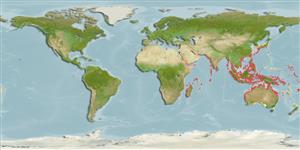Common names from other countries
Classification / Names / Names
Populärnamn | synonymer | Catalog of Fishes (gen., sp.) | ITIS | CoL | WoRMS
Environment: milieu / climate zone / depth range / distribution range
Ekologi
. Tropical
Indo-West Pacific.
Length at first maturity / Size / Vikt / Age
Maturity: Lm ? range ? - ? cm Max length : 4.0 cm SHL hane/ej könsbestämd; (Ref. 348); common length : 2.5 cm SHL hane/ej könsbestämd; (Ref. 348)
Local artisanal exploitation (Ref. 348). In sand and beach slopes in surf zones, migrating between the high and low tide marks with ebb and flow tides. Sometimes abundant. Occurs from low and high tide mark. Found burrowing in exposed sandy beaches (Ref. 125338).
Life cycle and mating behavior
Könsmognad | Reproduktion | Lek | Ägg | Fecundity | Larver
Members of the class Bivalvia are mostly gonochoric, some are protandric hermaphrodites. Life cycle: Embryos develop into free-swimming trocophore larvae, succeeded by the bivalve veliger, resembling a miniature clam.
Poutiers, J.M. 1998. (Ref. 348)
IUCN Red List Status (Ref. 130435)
CITES status (Ref. 108899)
Not Evaluated
Not Evaluated
Threat to humans
Harmless
Human uses
| FishSource |
Verktyg
Internet-källor
Estimates based on models
Preferred temperature
(Ref.
115969): 24.7 - 29.2, mean 28.4 (based on 2423 cells).
Resiliens
Hög, lägsta populationsfördubblingstid mindre än 15 månader (K=0.51-0.92).
Vulnerability
Low vulnerability (10 of 100).
